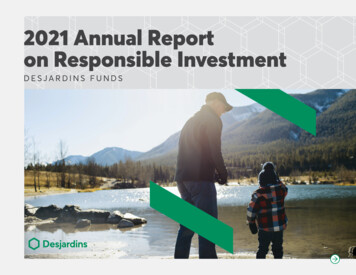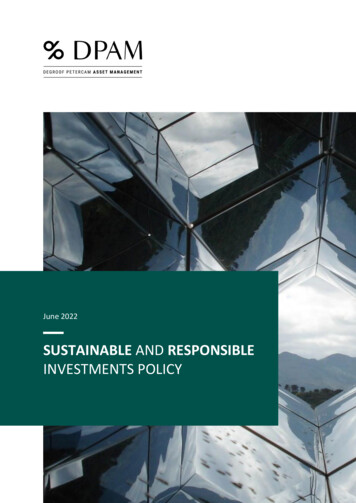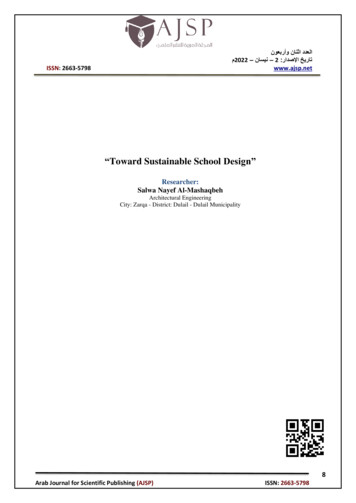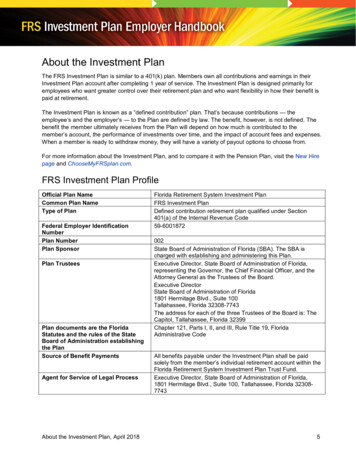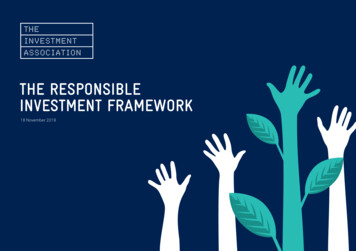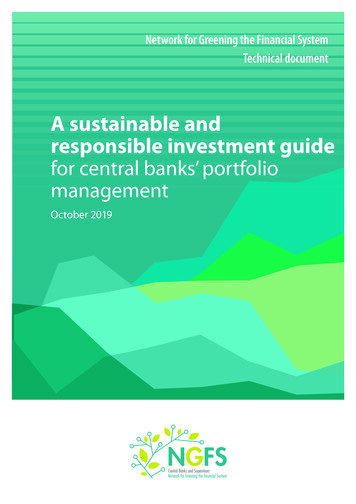
Transcription
Network for Greening the Financial SystemTechnical documentA sustainable andresponsible investment guidefor central banks’ portfoliomanagementOctober 2019
NGFSTechnical documentOCTOBER 2019This report has been coordinated by the NGFS Secretariat/Banque de France.For more details, go to www.ngfs.netand to the NGFS Twitter account @NGFS , or contact the NGFS t
Joint foreword by Frank Elderson and Dr. Sabine MaudererCFrank EldersonDr. Sabine MaudererChair of the NGFSChair of the workstream “Scaling up green finance”limate change is having significant effects on our economies, on our communities and on our lives. In 2018, nearly 900 naturaldisasters were recorded, leading to overall losses of around USD 180 billion. Only 45% of these losses were insured.The majority of losses were covered by private households, enterprises or public authorities.1It is quite evident that for all parties climate change is a source of financial risk that is becoming more urgent since the frequencyand severity of catastrophic events shows a growing trend. To address these challenges, international concerted efforts andcollective leadership are required. That’s exactly what we at the Network for Greening the Financial System (NGFS) are tryingto achieve.We believe that the financial community must play a key role in tackling climate change. In April 2019, the NGFS called forcollective action to address climate-related risks in the financial system, publishing a set of recommendations aimed at centralbanks, supervisors, policymakers and financial institutions.One of the recommendations is that NGFS members would lead by example. As a first step, we conducted a comprehensiveportfolio-management survey among our members on how they integrate sustainability factors. The results are presented inthis guide – the first of its kind. They are encouraging: many NGFS members already incorporate sustainability in their portfoliomanagement while others are reviewing their operations.The present guide targets all central banks, NGFS members as well as non-members. It offers valuable insight into Sustainableand Responsible Investment (SRI), presenting potential SRI approaches and ways to implement them. We are confident thatour guide will inspire others to follow suit and integrate SRI into their own operations.But we won’t stop here, as we will continue to do what we can to generate the necessary change towards a low-emissions future.Finally, we would like to thank all NGFS members who contributed to this report as well as the NGFS Secretariat for theirtireless efforts to make this guide possible. We need the support of each and every one of you to tackle this great challenge tohumankind: climate change.1 Cf. Munich Re NatCatSERVICE.NGFS REPORT2
ContentsExecutive summary5Origin of the NGFS61.Introduction72.Central bank portfolios72.1 Policy portfolios72.2 Own portfolios82.3 Pension portfolios82.4 Third-party portfolios8SRI objectives and scope93.4.5.6.3.1 Financial SRI objectives103.2 Extra-financial SRI objectives11Strategies124.1 Negative screening124.2 Best-in-class134.3 ESG integration144.4 Impact investing154.5 Voting and engagement18Monitoring195.1 Monitoring process195.2 Monitoring metrics19Reporting216.1 The case for central banks’ disclosures216.2 TCFD reporting by central banks21NGFS REPORT3
7.Implementation case studies237.1 Responsible investment at Norges Bank237.2 ESG integration at the Banca d’Italia247.3 Impact investing at the Banque de France257.4 Green bond investments at the Magyar Nemzeti Bank267.5 Exercising voting rights at the Swiss National Bank277.6 External manager selection at De Nederlandsche Bank287.7 SRI at the Banco de México29Bibliography31Acknowledgments34Annex 1: Risk-return characteristics of SRI35Annex 2: ESG data considerations36Annex 3: ESG and credit ratings37Annex 4: Examples of climate-related metrics38Glossary39NGFS REPORT4
Executive summaryThe members of the Network for Greening the FinancialSystem (NGFS) acknowledge climate change as a sourceof financial risk. The NGFS encourages central banks andsupervisors across the globe to lead by example and includesustainability considerations in their portfolio management,without prejudice to their primary mandates.This NGFS guide – the first of its kind – outlines ahands‑on approach aimed at central banks wishingto adopt SRI in their portfolio management. It does notoffer a one‑size‑fits‑all solution, but discusses potential SRIapproaches and ways to implement them, allowing centralbanks to accommodate their own specific challenges.The NGFS believes that the adoption of Sustainableand Responsible Investment (SRI)1 practices by centralbanks is important and can help to demonstrate thisapproach to other investors and mitigate material ESGrisks as well as reputational risks. As public institutions,central banks are subject to public scrutiny if they fail toaddress stakeholders’ concerns related to climate change.This is especially true if a central bank calls upon the financialsector to take account of climate‑related risks, but fails toappropriately address these risks in its own operations.There is a growing commitment to SRI strategies amongcentral banks. A unique SRI portfolio managementsurvey among NGFS members shows that 25 out of the27 respondents have already adopted SRI principles intheir investment approaches, or are planning to do so.These principles range from broad environmental, social,and governance (ESG) considerations (60% of the surveyrespondents) to climate‑specific focuses (16%).Central banks manage a large number of assets indifferent portfolios. However, they are not comparable toother institutional investors as their investment practicesare (to a large extent) dictated by the respective policyobjectives. Consequently, central banks face specificchallenges in the pursuit of SRI:1) Sticking to the legal policy mandate. The vast majorityof holdings are dictated by a policy objective. It is up toeach central bank to determine whether an SRI objectivecould be adopted without prejudice to its mandate.2) Investing responsibly while preserving liquidity.Central banks’ balance sheets largely consist ofsupranational and high‑grade sovereign debt with shortduration. The adoption of SRI is less straightforward forthese asset classes.3) Safeguarding independence and preventing conflictsof interest. Since central banks act as independentagents, any conflicts of interest arising from theirinvestment practices should be prevented.4) Striking a balance between transparency andconfidentiality. Transparency is key to any SRI approach.Nevertheless, central banks may not be able to discloseeverything about all of their investment practices as thiscould undermine the primary policy objective.Central banks may choose to adopt SRI to mitigatesustainability risks in their portfolio, or to create apositive impact on the environment and societyalongside financial returns. These objectives can betranslated into different SRI strategies. Among the five SRIstrategies identified in this guide, the most prominent aregreen bond investments and negative screening for equityand corporate bond holdings.This guide concludes with case studies of first‑handexperiences by NGFS members that already incorporateSRI principles in their portfolio management. While workis still needed with regard to critical elements relating tothe availability of data, to transparency, disclosure anda global taxonomy, progress is being made around theworld. These case studies are intended to help build criticalmomentum and lower barriers for other central banks tofollow suit, thereby speeding up the transition to a moresustainable economy.1 SRI comprises a broad range of sustainable investment strategies,including environmental, social and governance (ESG) criteria.NGFS REPORT5
Origin of the NGFS2017established a Networkof Central Banks and Supervisorsfor Greening the Financial System.TSUcentral banksand supervisorsETDECEMBERNONEPLAM M ISince then, the NGFS has grown to46Members9Observersrepresenting 5 continents.The NGFSis a coalitionof the willingIt is a voluntary, consensus-based forumwhose purpose is to share best practices,contribute to the development of climate–and environment– related riskmanagement in the financial sectorand mobilise mainstream financeto support the transition towarda sustainable economy.The NGFS issuesrecommendationswhich are not bindingbut are aimed at inspiringall central banks and supervisorsand relevant stakeholdersto take the necessarymeasures to fostera greener financial system.NGFS REPORT6
1. IntroductionThe urgency to act on climate change is growing. Accordingto the IPCC report 2018, temperatures are likely to increase1.5 C above pre-industrial levels between 2030 and 2052 ifemissions continue at the current rate. In order to be ableto address the risks posed to natural and human systems,associated with a temperature rise of 1.5 C or beyond, arapid and far-reaching transition is required. This transitiondemands significant upscaling of investments in options thathelp to reduce carbon emissions in all sectors (IPCC, 2018).The Network for Greening the Financial System (NGFS)aims to contribute to the development of environment andclimate risk management in the financial sector, as well asto mobilise mainstream finance to support the transitiontowards a sustainable economy (NGFS, 2018). In its firstcomprehensive report A Call for Action, the NGFS provided sixnon-binding recommendations for central banks, supervisors,policymakers and financial institutions to enhance their rolein the greening of the financial system and the managing ofenvironment and climate-related risks. In recommendation2, the NGFS encourages central banks to lead by example intheir own operations: without prejudice to their mandatesand status, this includes integrating sustainability factorsin the management of some of the portfolios at hand (ownfunds, pension funds and reserves to the extent possible).This document serves as a guide for central banks wishing toadopt Sustainable and Responsible Investment (SRI) principlesin one or more of their portfolios.The scope and limitations of SRI objectives and strategies arediscussed throughout this guide. Central banks’ investmentpractices are (to a large extent) dictated by their respectivelegal mandates. As such, this guide does not provide aone‑size‑fits all solution, but rather discusses potential SRIapproaches for central banks. Throughout this document, SRIis used as an umbrella term comprising multiple strategiesand investment practices. These range from specific focuseson sustainability risks to creating a positive impact, and fromclimate‑specific to broader ESG approaches. It is up to eachcentral bank to define the appropriate objectives and scopefor SRI, in line with the mandate of its own specific portfolios.This guide builds on the results of an SRI portfolio managementsurvey – the first of its kind – among NGFS members. Thesurvey shows that most central banks have already adopted(or are considering to adopt) SRI criteria for one or more oftheir portfolios. The increasing prevalence of SRI in centralbanks’ portfolio management mirrors the growing globalcommitments to address climate change and environmentalissues. Case studies of first-hand experiences by NGFSmembers that have already incorporated SRI principles in theirportfolio management can help build critical momentumand lower barriers for other central banks to follow suit.This guide provides an overview of the portfolios typicallymanaged by central banks (chapter 2) and describes the keymotivations for the adoption of SRI principles (chapter 3).Chapter 4 describes five possible SRI strategies, whilechapters 5 and 6 highlight the need for SRI monitoringand reporting. The document concludes with first‑handexperiences by NGFS members in the form of case studiesof seven selected members that have already incorporatedSRI in their portfolio management (chapter 7).2. Central bankportfoliosCentral banks typically hold different portfolios with variousgoals, depending on their respective mandates. This guidedistinguishes four types: (i) policy portfolios, (ii) ownportfolios, (iii) pension portfolios, and (iv) third‑partyportfolios. This chapter summarises the characteristics ofcentral bank holdings and portfolio characteristics.2.1 Policy portfoliosPolicy portfolios are at the heart of central banks’ mandates,and constitute by far the largest pool of assets on the balancesheet.1 As central banks have distinct legal mandates,the definition of policy portfolios in this guide is broad.It can include portfolios for foreign exchange intervention,the execution of an asset purchase programme or othermonetary policy goals. Notwithstanding the differentfunctions, the holdings within the policy portfolios mustmeet strict policy objectives, which typically requireinvestments to meet high standards in terms of liquidityand credit quality. Consequently, these portfolios mostly1 The survey shows that policy portfolios on average account for over 80% of total assets under management. Note that this number is derived fromportfolios for which SRI is under consideration or already implemented.NGFS REPORT7
consist of supranational and high‑grade sovereign debt,and may be subject to overriding principles such as marketneutrality. Still, some central banks manage their policyportfolios in a different manner, which could provide someroom for SRI principles. The extent to which SRI is applicablein the end depends on its compatibility with the respectivepolicy objective of the portfolio. Box 1 shows the currentstate of SRI adoption for the four portfolio types.2.2 Own portfoliosMany central banks manage own portfolios. These portfoliostypically have the objective of generating returns within acertain risk tolerance level. The asset mix of these portfoliosis more diverse compared to the policy portfolios, withholdings often including equities, corporate bonds andsometimes private debt.2 Some central banks invest theseholdings in a market‑neutral manner to limit the impact onthe constitution of the broader market. Adoption of SRI isrelatively straightforward for central banks’ own portfolios,as long as it does not interfere with the primary objective.2.3 Pension portfoliosPension portfolios serve as a long‑term savings account forretirement and have a longer investment horizon. While theasset allocation is largely determined by the nature of theunderlying pension liabilities, central banks’ pension funds aregenerally invested in more diverse asset classes and geographiclocations compared to the own portfolios and policy portfolios.The holdings are also subject to a fiduciary duty. As such, theremay be room to adopt SRI as long as this is in line with thefiduciary duty (this is further discussed in chapter 3).2.4 Third‑party portfoliosMany central banks manage portfolios on behalf of a third party.Examples include the local government’s foreign reserves, orthe ECB’s foreign reserves which are managed by nationalcentral banks within the Eurosystem. The objectives and assetallocation of these portfolios vary, as they are determinedby the third party. The extent to which SRI can be adoptedin these portfolios thus depends on the client’s demands.Box 1SRI in central banks’ portfoliosThe NGFS survey covers 27 central banks. In total 25 manageone or more portfolios for which SRI is already included orunder consideration. Of these 25, all have adopted, or areconsidering adopting, SRI principles in their own portfolios.For the policy portfolios, pension portfolios and third‑partyportfolios, the survey results are more balanced, as roughlyhalf of the respondents indicate that they have adopted, orare considering adopting, SRI principles in these portfolios.These relatively high shares reflect the broad definition of“the incorporation of SRI principles”, which covers varyingstrategies and may be applied only to specific parts (assetclasses) of central banks’ portfolios (see chapter 4). Moreover,as outlined in paragraph 2.1, policy portfolios can servedifferent functions across central banks. Most centralbanks that apply a form of SRI to their policy portfolio,indicate this refers to their foreign exchange portfolio.C1 SRI in central banks’ s5072030604050Under consideration60708090100NoSource: NGFS SRI portfolio management survey 2019.Note: 27 respondents. In total, the surveyed central banks manage68 portfolios: 24 policy portfolios, 12 pension portfolios, 15 third‑partyportfolios, and 17 own portfolios. Note that there are 17 own portfoliosmanaged by 15 central banks (two respondents have 2 separate ownportfolios). The survey only included pension portfolios that are part ofcentral banks’ balance sheets. This means central banks’ pension portfoliosmanaged by an independent entity are not represented.2 Over the last few years, central banks have broadened their assets under management, holding around USD 800 billion in equities (6% of total) andUSD 1 trillion in return‑enhancing bonds (9% of total) (OMFIF, 2019).NGFS REPORT8
T1 Characteristics of typical central bank portfoliosPolicy portfoliosOwn portfoliosDictatedbyPolicy goal – determinedby central bank mandate.MainTo support, implementobjective and maintain confidencein monetary policy andcurrency management.Character Assets meet high standardsin terms of liquidity andcredit quality in order tobe able to absorb shocksin times of crisis or whenaccess to borrowing iscurtailed. Can be subject tomarket neutrality.AssetLimited. Mostly (sub-)classessovereigns, supranationalsand agency (SSA) and somecorporate/covered bondsand equity.Duration From short to mediumterm. From 3-6 years formajority. Less than 2 yearsfor one-thirdof respondents.Financial return goal – e.g.to help cover operatingexpenses.To generate returns withinset risk tolerance levels.Secondary objectivecan be to gather marketintelligence.Subject to risk-returnconsiderations. Morefreedom in investmentdecisions, but interferencewith monetary policy orcurrency managementshould be prevented.Pension portfoliosFiduciary duty – managedon behalf of beneficiaries.To provide for theretirement pensionobligations of the centralbank’s employees.Long term investmenthorizon in line withthe pension liabilities.Short-term volatility is lessof a concern.Third-party portfoliosThird-party mandate –managed on behalf of anexternal party.Set by a third party. Varies,e.g. financial return,short-term liquidityprovision or foreignexchange intervention.Depends on main objectiveof funds. Cases wherecentral bank managesforeign exchangereserves on behalf of thegovernment.Diverse. Mix between SSA,corporate/covered bondsand equity, and potentiallyprivate debt.Diverse. Mix between SSA,corporate/covered bonds,equity, and private debt.Diverse. Mainly SSA,followed by corporate/covered bonds, and equity.Short term. Less than 2years for majority.Longer term. More than 6years for two-thirds of therespondents.Balanced. Varies fromshort term (0-2 years),medium term (3-6 years)and longer term ( 6 years).ConclusionPolicy portfolios constitute the largest pool of assets managedby central banks and mainly consist of supranational andhigh‑grade sovereign debt. These holdings are subject toa policy mandate. Some central banks also manage ownportfolios, which typically provide room to adopt an SRIobjective alongside the objective to generate financialreturns. The remainder of central bank holdings is in pensionportfolios or third‑party portfolios, which are driven bybeneficiaries’ and clients’ demands. The characteristicsof the different portfolio types are summarised inTable 1.3 In general, the specific portfolio objectives andcharacteristics determine the extent to which SRI objectivescan be adopted. Both topics are further discussed in thefollowing chapters.3. SRI objectivesand scopeIn general, two high‑level SRI objectives for central bankportfolios can be identified: (i) a financial SRI objectivewhich aims to address the impact of climate‑relatedrisks and/or ESG‑related risks on the portfolio and (ii) anextra‑financial SRI objective which aims to address theimpact of the portfolio on the environment and society,alongside financial returns (see Figure 1).4 These objectivesare increasingly likely to overlap as adaptation and mitigationpolicies evolve in response to climate change. An issuer’simpact on climate change and the broader environmentcan translate into financially material opportunities or risks(European Commission, 2019b). Both SRI objectives can be3 The reported data may be subject to bias, as only those portfolios are reflected for which SRI is already adopted or under consideration. Thecharacteristics of the portfolios might, however, influence the decision to adopt SRI objectives.4 These high‑level objectives are closely aligned with the European Commission’s double materiality perspective which distinguishes financial materiality(the impact of climate change on a company’s development, performance and position), and environmental and social materiality (the impact of acompany’s activities on the environment and society) (European Commission, 2019b). For a climate‑specific scope, the two high‑level goals can betranslated into a carbon risk objective and a climate friendliness objective (WRI, UNEP-FI & 2 Investing Initiative, 2015).NGFS REPORT9
F1 High-level objectives for central banks’ portfolio managementFINANCIAL OBJECTIVE:addressing the impact of climate-related risksand/or ESG-related risks on the portfolioEXTRA-FINANCIAL OBJECTIVE:addressing the impact of the portfolioon the environment and societytranslated into concrete goals with either a climate‑specificscope or a broader ESG scope (Box 2). The extent to whichthe SRI objectives and scope may be pursued depends onthe central bank portfolio under consideration.3.1 Financial SRI objectivesBox 2SRI scope in central banks’portfolio managementThe NGFS survey shows that 60% of the central bankshave a broad ESG approach, while 16% employs aclimate‑specific focus. Some central banks are stilldeciding upon their scope.C2 SRI scope in central banks’ portfoliomanagement(%)816An investor with a financial SRI objective does not aim togenerate a positive environmental or social impact, butstrives to improve the risk‑return profile of the portfolio byconsidering financially material ESG criteria. Protecting theportfolio against climate‑related risks, environmental risks,or ESG‑related risks are examples of financial SRI objectives.The financial risks associated with climate change arise fromtwo risk categories. The first category relates to physicalrisks due to climate‑related damage from, for example,storms, hail and flooding. The second category arises fromtransition risks due to the shift towards a low carbon economy(NGFS, 2019). Comparable channels have been identified forother environmental and social risks, such as risks related towater stress, biodiversity loss, resource scarcity and humanrights controversies (Schellekens and van Toor, 2019). Theextent to which integration of these risks helps to improvean investor’s risk‑adjusted returns is discussed in Annex 1.6016Broad ESG approachSpecific focuson climate changeOtherUnder considerationSource: NGFS SRI portfolio management survey 2019.Note: 25 respondents.Financial SRI objectives are well aligned with centralbanks’ SRI motivations. According to the NGFS survey results,key motivations for SRI among central banks are protectionagainst sustainability risks (including climate‑related financialrisks) and enhancement of the risk‑return profile (Box 3).5These motivations are driven by the desire to protect orimprove financial performance.5 Similar results are found amongst asset owners and managers who feel the responsibility to address sustainability, with key motivations beingdownside risk protection and financial return generation (Morgan Stanley, 2018).NGFS REPORT10
Box 3Central banks’ motivations for SRIThe mitigation of reputational risk, and setting a goodexample, are important motivations for central banks toadopt SRI. All investors face reputational risk associatedwith investing in controversial companies and/or countries.For central banks, this risk might be elevated in casethey explicitly call for action by the financial industry toaddress climate‑related risks or ESG‑related risks, but failto incorporate these risks in their own operations.C3 Central banks’ motivations for SRIMitigate reputational risk201Protecting against sustainability risks155To set a good example153Enhancing risk-return profile142Demand from beneficiaries and stakeholders81Complying with international standards or frameworks8055Fiduciary dutyOther39050100150200250Source: NGFS SRI portfolio management survey 2019.Note: The 25 respondents ranked their motivation (1-8) for each of theportfolios in which SRI plays a role (38 portfolios in total).For own portfolios and pension portfolios, adopting afinancial SRI objective is in line with the (primary) goalof generating financial returns.6 For policy portfolios andthird‑party portfolios, the extent to which this SRI objectivecan be adopted depends on the (policy) objective(s) of theportfolio and clients’ demands.3.2 Extra‑financial SRI objectivesAn investor with an extra‑financial SRI objective aims tomake a positive tangible impact on society by allocatingcapital to sustainable companies or projects, alongsidegenerating financial returns. Actively helping to finance theSustainable Development Goals (SDGs) or the transition(or “just transition”) towards a carbon neutral economy areexamples of extra‑financial SRI objectives.7Adoption of extra‑financial SRI objectives may be lessstraightforward for central banks. The NGFS surveyshows that motivations related to extra‑financial SRIobjectives, such as compliance with international standardsor frameworks, are mentioned less prominently (Box 3).Nevertheless, a few respondents explicitly mention ethicalconsiderations and striving for a positive impact under “other”.Where it is consistent with their mandates, there could bemerit in central banks striving for a positive extra‑financialimpact. This could help drive the transition towards a carbonneutral economy and mitigate ESG risks to the financialsector (Schellekens & van Toor, 2019).The extent to which an extra‑financial objective suits acentral bank varies per portfolio. An important considerationis whether some financial return would have to be sacrificedto generate a positive extra‑financial impact. Within theown portfolios, central banks typically have flexibilityto set their own targets, which provides scope for anextra‑financial SRI objective. With regard to the pensionportfolios, the fiduciary duty dictates that beneficiaries areconsulted if an extra‑financial SRI objective could impactfinancial returns. For the policy portfolios and third‑partyportfolios, the adoption of an extra‑financial SRI objectiveis relatively complex, as this could undermine the primarypolicy objective or jeopardise central bank’ independence.6 UNEP (UN Environmental Programme) and PRI (Principles for Responsible Investment) argue that taking ESG criteria into account in a pensionportfolio can even be considered part of the fiduciary duty “as long as these criteria are shown to have a long‑term effect on the financial performanceof companies” (i.e. are financially material) (UNEP & PRI, 2015).7 The 17 SDGs, adopted by all UN Member States in 2015, aim to end global poverty by 2030 while maintaining planetary stability. Governments,foundations and the private sector were explicitly called upon by the UN to mobilise more financial resources to help deliver these SDGs (OECD, 2019).A “just transition” focusses on climate action that explicitly incorporates transitional challenges from a social perspective (Grantham Research Instituteon Climate Change, 2018).NGFS REPORT11
T2 Applicability of high-level SRI objectives for central banks’ portfoliosSRI ObjectivePolicy portfoliosOwn portfoliosPension portfoliosFinancialDepends on portfolioobjectives.In line with portfolio’sfinancial return objective.Extra-financialDepends on portfolioobjectives.Potentially room to adoptextra-financial objectives.ConclusionThe room to adopt SRI objectives in central banks’ portfolios,largely depends on the mandate underlying the portfolioin question. In general, two high‑level SRI objectives canbe considered: (i) a financial SRI objective and (ii) anextra‑financial SRI objective. The first is aligned with anyportfolio that aims to generate financial returns. The secondcan be considered, but depends on its compatibility withthe portfolio’s primary objective or stakeholders’ demands.Table 2 summarises the applicability of the SRI objectivesper portfolio.4. StrategiesDepending on their respective SRI objective (financial orextra‑financial), central banks can consider different SRIstrategies. This chapter describes the most commonlyused SRI strategies and – given the lack of a commonlyaccepted list of definitions – builds on the set of strategiespresented by Eurosif and the PRI. As a result, five SRI strategiesare discussed: (i) negative screening, (ii) best‑in‑class,(iii) ESG integration, (iv) impact investing and (v) votingand engagement ((Eurosif, 2019) and (PRI, 2018)). Thediscussed SRI strategies are not mutually exclusive andcan be combined. Since data plays a key role for theimplementation of any SRI strategy, a discussion of ESGdata considerations can be found in Annex 2.In line with financialreturn objective (andfiduciary duty).Depends on beneficiaries’demands.Third-party portfoliosDepends on portfolioobjectives.Depends on clients’d
to adopt SRI in their portfolio management. It does not offer a one‑size‑fits‑all solution, but discusses potential SRI approaches and ways to implement them, allowing central banks to accommodate their own specific challenges. There is a growing commitment to SRI strategies among central banks. A unique SRI portfolio management
